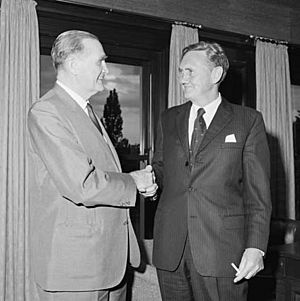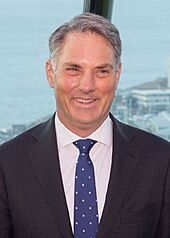Deputy Prime Minister of Australia facts for kids
Quick facts for kids Deputy Prime Minister of Australia |
|
|---|---|

|
|

|
|
| Australian Government Department of the Prime Minister and Cabinet |
|
| Style | The Honourable |
| Abbreviation | DPM |
| Member of |
|
| Reports to | Prime Minister |
| Seat | Canberra |
| Nominator | Prime Minister |
| Appointer | Governor-General of Australia
on the advice of the prime minister
|
| Term length | At the Governor-General's pleasure |
| Formation | 10 January 1968 |
| First holder | John McEwen |
| Salary | AU$416,212 |
The Deputy Prime Minister of Australia is the second most important leader in the Australian Government. This person helps the Prime Minister run the country. The job of Deputy Prime Minister was officially created in 1968. Before that, people used the title unofficially.
The Governor-General appoints the Deputy Prime Minister. This happens after the Prime Minister suggests who it should be. If the Labor Party is in charge, their deputy leader becomes the Deputy Prime Minister. If the Coalition (a group of parties) is in charge, the leader of the National Party usually gets the job.
In 2017, the position became empty for the first time. This happened because Barnaby Joyce, who was the Deputy Prime Minister, was found to have New Zealand citizenship. Australian law says that Members of Parliament cannot be citizens of another country. The High Court of Australia made this decision. Joyce later won a special election and got his job back.
Contents
History of the Role

For a long time, the Deputy Prime Minister was not an official job. It was more like an honorary title for the second most important minister. This started to become more important after the 1922 election. The Nationalist Party needed help to form a government. They teamed up with the Country Party. The leader of the Country Party, Earle Page, became the second-in-command. Even though his official title was Treasurer, he was seen as the deputy to Prime Minister Stanley Bruce.
By 1946, the title "deputy prime minister" was being used in official government documents. But it was still not an official position.
From then until 1968, the agreement between the Liberal Party (and its earlier forms) and the Country Party (now the National Party) meant that the Country Party leader was always second in the government. This is still true when the Coalition is in power. When the Labor Party is in power, their deputy leader is second in command.
On 19 December 1967, John McEwen became the temporary Prime Minister. This happened after Prime Minister Harold Holt suddenly disappeared. McEwen was the leader of the Country Party. He had been an important minister for a very long time. To recognise his long service and his high rank, the new Prime Minister, John Gorton, officially created the job of Deputy Prime Minister. John McEwen became the very first person to hold this official title on 10 January 1968.
Since 1968, only three Deputy Prime Ministers have later become Prime Minister. They were all from the Labor Party: Paul Keating, Julia Gillard, and Anthony Albanese. Both Keating and Gillard became Prime Minister when the current Prime Minister lost support from their party. Anthony Albanese was briefly Deputy Prime Minister in 2013. He later led the Labor Party to win the 2022 election and became Prime Minister.
In November 2007, Julia Gillard made history. She became Australia's first female Deputy Prime Minister. She was also the first Deputy Prime Minister born outside Australia.
In 2017, the job was empty for 40 days. This was the longest time it had been unoccupied. This happened because Barnaby Joyce was found to be a citizen of New Zealand. Australian law says that Members of Parliament cannot have dual citizenship. Joyce fixed his citizenship issue. He then won a special election for his seat. The Governor-General re-appointed him as Deputy Prime Minister on 6 December 2017.
In reality, only leaders of the National Party or deputy leaders of the Labor Party have held this position.
What the Deputy Prime Minister Does
The Deputy Prime Minister is always a member of the Cabinet. The Cabinet is a group of senior ministers who make important decisions. The Deputy Prime Minister also always has at least one other important job, called a "portfolio."
Taking Over from the Prime Minister
The Deputy Prime Minister becomes the acting Prime Minister if the Prime Minister cannot do their job for a short time. This might happen if the Prime Minister is sick, travelling overseas, or on holiday. If both the Prime Minister and Deputy Prime Minister are unavailable, another senior minister takes over.
If the Prime Minister were to die, the Governor-General would appoint the Deputy Prime Minister as Prime Minister. This would be a temporary role until the government chooses a new leader.
Salary
Members of Parliament get a basic salary. The Deputy Prime Minister gets an extra amount on top of this. This extra pay is about 105 percent of the basic salary. This means the Deputy Prime Minister earns a total of $416,212 per year. They also receive other allowances and benefits.
List of Deputy Prime Ministers of Australia
Here are the people who have officially held the job of Deputy Prime Minister of Australia since it was created in 1968:
| No. | Portrait | Deputy Prime Minister | Political Party and position |
Portfolio(s) | Term of office | Prime Minister | |||
|---|---|---|---|---|---|---|---|---|---|
| Took office | Left office | Time in office | |||||||
| 1 |  |
John McEwen | Country Leader 1958–71 |
Trade and Industry | 10 January 1968 | 5 February 1971 | 3 years, 26 days | John Gorton | |
| 2 |  |
Doug Anthony | Country Leader 1971–84 |
5 February 1971 | 5 December 1972 | 1 year, 304 days | |||
| William McMahon | |||||||||
| 3 |  |
Lance Barnard | Labor Deputy Leader 1967–74 |
Defence | 5 December 1972 | 12 June 1974 | 1 year, 189 days | Gough Whitlam | |
| 4 |  |
Jim Cairns | Labor Deputy Leader 1974–75 |
Treasurer | 12 June 1974 | 2 July 1975 | 1 year, 20 days | ||
| 5 |  |
Frank Crean | Labor Deputy Leader 1975 |
Overseas Trade | 14 July 1975 | 11 November 1975 | 132 days | ||
| (2) |  |
Doug Anthony | Country National Leader 1971–84 |
Trade and Industry | 12 November 1975 | 11 March 1983 | 7 years, 119 days | Malcolm Fraser | |
| 6 |  |
Lionel Bowen | Labor Deputy Leader 1977–90 |
Trade Attorney-General |
11 March 1983 | 4 April 1990 | 7 years, 24 days | Bob Hawke | |
| 7 |  |
Paul Keating | Labor Deputy Leader 1990–91 |
Treasurer | 4 April 1990 | 3 June 1991 | 1 year, 60 days | ||
| 8 |  |
Brian Howe | Labor Deputy Leader 1991–95 |
Health, Housing and Community Services, Assisting for Social Justice, Assisting for Commonwealth-State Relations | 3 June 1991 | 20 December 1991 | 4 years, 17 days | ||
| 20 December 1991 | 24 March 1993 | Paul Keating | |||||||
| Housing, Local Government and Community Services | 24 March 1993 | 23 December 1993 | |||||||
| Housing, Local Government and Human Services | 23 December 1993 | 25 March 1994 | |||||||
| Housing and Regional Development | 25 March 1994 | 20 June 1995 | |||||||
| 9 |  |
Kim Beazley | Labor Deputy Leader 1995–96 |
Finance | 20 June 1995 | 11 March 1996 | 265 days | ||
| 10 |  |
Tim Fischer | National Leader 1990–99 |
Trade | 11 March 1996 | 20 July 1999 | 3 years, 131 days | John Howard | |
| 11 |  |
John Anderson | National Leader 1999–2005 |
Transport and Regional Development | 20 July 1999 | 6 July 2005 | 5 years, 351 days | ||
| 12 |  |
Mark Vaile | National Leader 2005–2007 |
Trade Transport and Regional Services |
6 July 2005 | 3 December 2007 | 2 years, 150 days | ||
| 13 |  |
Julia Gillard | Labor Deputy Leader 2006–10 |
Employment and Workplace Relations Education Social Inclusion |
3 December 2007 | 24 June 2010 | 2 years, 203 days | Kevin Rudd | |
| 14 |  |
Wayne Swan | Labor Deputy Leader 2010–13 |
Treasurer | 24 June 2010 | 27 June 2013 | 3 years, 3 days | Julia Gillard | |
| 15 |  |
Anthony Albanese | Labor Deputy Leader 2013 |
Broadband, Communications and the Digital Economy Infrastructure and Transport |
27 June 2013 | 18 September 2013 | 83 days | Kevin Rudd | |
| 16 |  |
Warren Truss | National Leader 2007–16 |
Infrastructure and Regional Development | 18 September 2013 | 18 February 2016 | 2 years, 153 days | Tony Abbott | |
| Malcolm Turnbull | |||||||||
| 17 |  |
Barnaby Joyce | National Leader 2016–18 |
Agriculture and Water Resources Resources and Northern Australia (2017) |
18 February 2016 | 27 October 2017 | 1 year, 251 days | ||
| Infrastructure and Transport | 6 December 2017 | 26 February 2018 | 82 days | ||||||
| 18 |  |
Michael McCormack | National Leader 2018–2021 |
Infrastructure, Transport and Regional Development | 26 February 2018 | 22 June 2021 | 3 years, 116 days | ||
| Scott Morrison | |||||||||
| (17) |  |
Barnaby Joyce | National Leader 2021–2022 |
22 June 2021 | 23 May 2022 | 335 days | |||
| 19 |  |
Richard Marles | Labor Deputy Leader 2019–present |
Defence | 23 May 2022 | Incumbent | 3 years, 213 days | Anthony Albanese | |
Former Deputy Prime Ministers Still Living
As of July 2025, there are 11 former Deputy Prime Ministers of Australia who are still alive. The oldest is Brian Howe, who was born in 1936.
Here is a list of them:
- Paul Keating (1990–91)
- Brian Howe (1991–95)
- Kim Beazley (1995–96)
- John Anderson (1999–05)
- Mark Vaile (2005–07)
- Julia Gillard (2007–10)
- Wayne Swan (2010–13)
- Anthony Albanese (2013)
- Warren Truss (2013–16)
- Barnaby Joyce (2016–18, 2021–22)
- Michael McCormack (2018–21)


